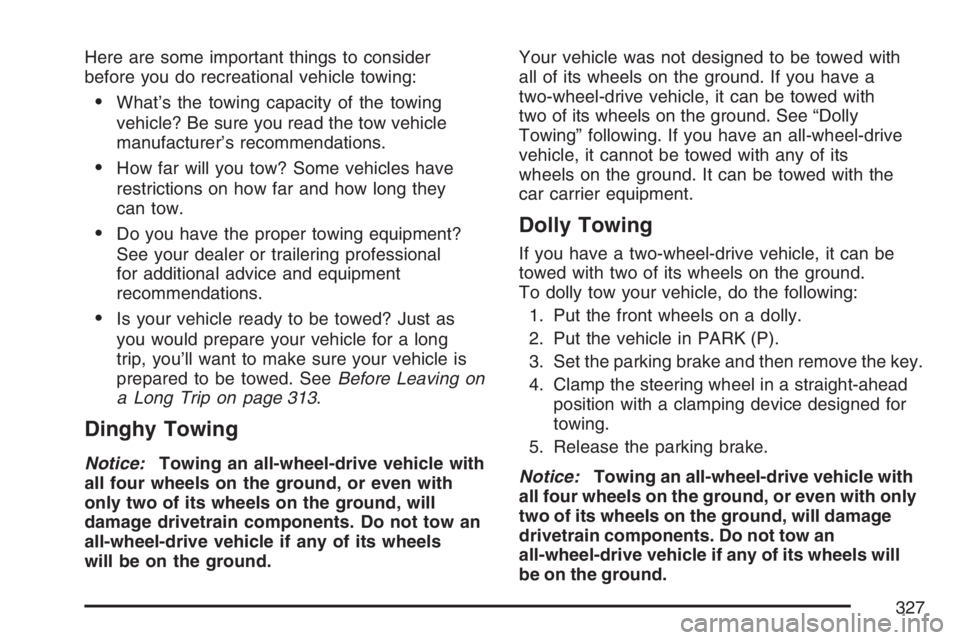Page 207 of 490

SERVICE STABILITRAK
This message displays if there has been a
problem detected with the StabiliTrak®System.
A warning light also appears on the instrument
panel cluster. SeeTraction Control System (TCS)
Warning Light on page 182. SeeStabiliTrak
®
System on page 298for more information.
If this message turns on while you are driving, pull
off the road as soon as possible and stop
carefully. Try resetting the system by turning the
ignition off and then back on. If this message
still stays on or turns back on again while you are
driving, your vehicle needs service. Have the
StabiliTrak
®System inspected by your dealer as
soon as possible.
SERVICE THEFT DETERRENT SYSTEM
This message displays when there is a problem
with the theft-deterrent system. A fault has
been detected in the system which means that the
system is disabled and it is not protecting the
vehicle. The vehicle usually restarts; however, you
may want to take the vehicle to your dealer
before turning off the engine. SeePASS-Key
®III+
Operation on page 113for more information.
SERVICE TIRE MONITOR SYSTEM
This message displays if a part on the Tire
Pressure Monitor (TPM) system is not working
properly. If you drive your vehicle while any of the
four sensors are missing or inoperable, the
warning comes on in about 20 minutes. A sensor
would be missing, for example, if you put
different wheels on your vehicle without
transferring the sensors. If the warning comes on
and stays on, there may be a problem with the
TPM. See your dealer.
SERVICE TRACTION CONTROL
This message displays when the Traction Control
System (TCS) is not functioning properly. A
warning light also appears on the instrument panel
cluster. SeeTraction Control System (TCS)
Warning Light on page 182andTraction Control
System (TCS) on page 297for more information.
Have the TCS serviced by your dealer as soon
as possible.
207
Page 327 of 490

Here are some important things to consider
before you do recreational vehicle towing:
What’s the towing capacity of the towing
vehicle? Be sure you read the tow vehicle
manufacturer’s recommendations.
How far will you tow? Some vehicles have
restrictions on how far and how long they
can tow.
Do you have the proper towing equipment?
See your dealer or trailering professional
for additional advice and equipment
recommendations.
Is your vehicle ready to be towed? Just as
you would prepare your vehicle for a long
trip, you’ll want to make sure your vehicle is
prepared to be towed. SeeBefore Leaving on
a Long Trip on page 313.
Dinghy Towing
Notice:Towing an all-wheel-drive vehicle with
all four wheels on the ground, or even with
only two of its wheels on the ground, will
damage drivetrain components. Do not tow an
all-wheel-drive vehicle if any of its wheels
will be on the ground.Your vehicle was not designed to be towed with
all of its wheels on the ground. If you have a
two-wheel-drive vehicle, it can be towed with
two of its wheels on the ground. See “Dolly
Towing” following. If you have an all-wheel-drive
vehicle, it cannot be towed with any of its
wheels on the ground. It can be towed with the
car carrier equipment.
Dolly Towing
If you have a two-wheel-drive vehicle, it can be
towed with two of its wheels on the ground.
To dolly tow your vehicle, do the following:
1. Put the front wheels on a dolly.
2. Put the vehicle in PARK (P).
3. Set the parking brake and then remove the key.
4. Clamp the steering wheel in a straight-ahead
position with a clamping device designed for
towing.
5. Release the parking brake.
Notice:Towing an all-wheel-drive vehicle with
all four wheels on the ground, or even with only
two of its wheels on the ground, will damage
drivetrain components. Do not tow an
all-wheel-drive vehicle if any of its wheels will
be on the ground.
327
Page 398 of 490

The TPMS matching process is outlined below:
1. Set the parking brake.
2. Turn the ignition switch to RUN with the
engine off.
3. Using the DIC, press the vehicle information
button until the TIRE LOCATIONS PRESS
V
TO LEARN message displays.
4. Press the set/reset button to allow the system
to learn the tire positions. The horn will sound
twice to indicate the receiver is ready, and
the TIRE LEARNING ACTIVE message
displays. The TPMS system is ready for the
sensor matching process to begin.
5. Start with the driver side front tire.
6. Remove the valve cap from the tire’s valve
stem. Activate the TPMS sensor by increasing
or decreasing the tire’s air pressure for
�ve seconds, or until a horn chirp sounds.The horn chirp, which may take up to
30 seconds to sound, con�rms that the sensor
identi�cation code has been matched to the
tire/wheel position. To decrease the tire’s
air-pressure use the pointed end of the valve
cap, a pencil-style air pressure gage, or a key.
7. Proceed to the passenger side front tire, and
repeat the procedure in Step 6.
8. Proceed to the passenger side rear tire, and
repeat the procedure in Step 6.
9. Proceed to the driver side rear tire, and
repeat the procedure in Step 6.
10. After hearing the con�rming horn chirp for the
driver side rear tire, the tire learning process
ends. Turn the ignition switch to LOCK.
11. Set all four tires to the recommended air
pressure level as indicated on the tire and
loading information label.
12. Put the valve caps back on the valve stems.
398